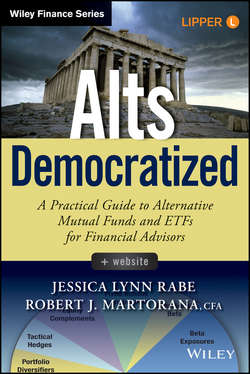Читать книгу Alts Democratized - Rabe Jessica Lynn - Страница 9
На сайте Литреса книга снята с продажи.
Chapter 1
Definitions and Methodology
Definitions
ОглавлениеAlts Democratized defines liquid alternatives as hedge fund strategies in an Investment Company Act of 1940 ('40 Act) wrapper, such as an exchange-traded fund (ETF) or a mutual fund. This description concurs with the 11 alternative classifications used by Lipper, and the definition emphasizes the investment strategy rather than the legal structure.
The term hedge fund strategies includes a broad range of investment vehicles that operate in a different legal structure. Hedge funds are usually pooled vehicles with investments managed in a general partner/limited partner structure, and held by a limited liability company. These funds have fewer restrictions on the investment strategy, manager compensation, and public disclosures than do '40 Act investments.
Traditional hedge funds are designed for accredited investors, and typically have high minimum investments, limited liquidity, and long lockup periods. Investors get K-1 statements that can make tax reporting difficult, and the paperwork and suitability requirements are demanding.
When we mention “traditional alternatives,” this refers to single-manager hedge funds, fund-of-funds hedge funds, private equity, and privately held real estate. These traditional alternatives are usually available only to high-net-worth investors, and this gives wide latitude to hedge fund managers.
In contrast, '40 Act investments are meant for the masses, and have strict regulatory requirements, including limits on leverage and illiquid assets. For example, '40 Act funds can have borrowings of no more than one-third of total assets, and this reduces their ability to replicate certain hedge fund strategies that rely on high leverage (credit arbitrage). Also, '40 Act investments limit holdings of illiquid assets and transactions with affiliated persons, which makes it difficult to participate in private equity strategies such as venture capital. And '40 Act funds have strict disclosure requirements about the positions they hold and the compensation paid to investment managers, and these disclosures are made through the filing of the prospectus, annual report, and statement of additional information. These funds usually offer daily liquidity to investors who seek redemptions, though this is not true for closed-end funds or interval funds. There are many other legal nuances that distinguish traditional and liquid alts, but the main differences involve fees, liquidity, transparency, and taxation.
Today the lines between '40 Act funds and limited partnerships are blurring as traditional alternative fund managers enter the '40 Act space in search of broader distribution. The entrance of traditional alternative managers is leading to product innovation and a breadth of new choices for advisors and investors, and this requires new approaches to fund research and deeper levels of fund manager due diligence.
